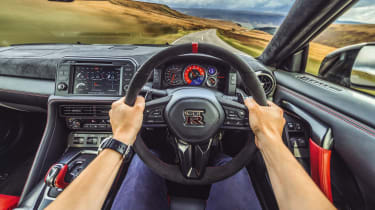Nissan GT-R (R35, 2009 - 2022) review – interior and tech
The GT-R's cabin and refinement could never live with plusher, more exotic European rivals. Improvements made in 2017 did bestow a certain quality that was absent before.
The cabin of the Nissan GT-R even when new, was more a technical spectacle than a plush, cosetting place in which to find yourself. The Gran Turismo-spec graphics wouldn't be found anywhere else but still, some nicer materials and better fit and finish would have been welcome for what had become a £75k car before its 2017 update. That's exactly what the cabin of the 2017 model got. Though it's familiar to those accustomed to the GT-R, there's a bigger infotainment screen, revised new steering wheel and carbon on the transmission tunnel. There is also a knob down near the bright red starter button that controls the satnav and radio and works much like BMW’s iDrive controller.
The GT-R’s column-mounted paddles were replaced with ones attached to the back of the steering wheel. We prefer the longer throw of the old versions, but that’s really just personal preference.
It still isn’t the sort of cabin that will delight aesthetes, but it's better made, with nicer materials and modernised by comparison to before. Some extra leather makes it feel a bit less utilitarian and the larger infotainment screen feels less of an afterthought.
The Polyphony Digital- (studio behind Gran Turismo) are responsible for the GT-R's infotainment system. It's nice to be able to customise the information it shows, choosing from things like yaw and g sensors as well as seeing boost pressure displayed while you drive.
The carbonfibre backed seats and Alcantara steering wheel in the GT-R Nismo do elevate its interior beyond the standard GT-R. While it does feel more special, it's not supercar special, even for what was supercar money.




